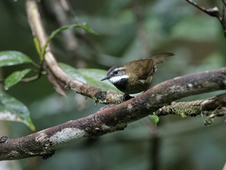
The latest Action Plan for Australian Birds, released in December 2021, reveals that one in six bird species or subspecies are nationally threatened. Climate change is emerging as the greatest threat to Australia’s birds, with unprecedented frequency and intensity of drought, fires and heat driving species towards extinction. However, the report also illustrates conservation success stories, with declines of several species slowed or reversed by well-implemented conservation actions.

BirdLife Australia, in collaboration with Charles Darwin University, released a revised and updated Action Plan for Australian Birds in December 2021, providing the most comprehensive overview of the status of Australia’s avifauna yet. Written by over 300 experts, it reports a decade of monitoring and assessment of Australia’s birds and lays out the actions necessary to conserve those at greatest risk of extinction.
The report reveals that 188 bird species or subspecies (approximately one in six) have been assessed as nationally threatened. Of these, 23 are Critically Endangered (of which two are possibly extinct), 76 are Endangered, and 89 are Vulnerable, while a further 35 are Near Threatened. Three birds considered Critically Endangered (Possibly Extinct) in the last report in 2010 are now classified nationally as Extinct – Mount Lofty Ranges Spotted Quail-thrush Cinclosoma punctatum anachoreta, Southern Star Finch Neochmia ruficauda ruficauda and White-chested White-eye Zosterops albogularis.
The publication recommends that the global IUCN Red List status of 43 species requires revision, with 15 recommended to be moved to a lower threat category (i.e. the status has improved) and the remaining 28 to be placed in a higher threat category. These include three species — Buff-breasted Buttonquail Turnix olivii, Baudin’s Black-cockatoo Zanda baudinii and Night Parrot Pezoporus occidentalis — that are recommended to be uplisted to Critically Endangered, meaning they now face an extremely high risk of extinction in the wild.
The report highlights the increasing role of climate change as a key threat to bird populations. Australia has seen unprecedented drought, fires and heat in recent years. Several of the species that have worsened in conservation status over the last decade are found in the upland rainforests of the Queensland Wet Tropics bioregion. These include Fernwren Oreoscopus gutturalis, Mountain Thornbill Acanthiza katherina and Atherton Scrubwren Sericornis keri. For these cool-adapted birds, climate change is creating an “escalator to extinction”, forcing them to shift their distributions to higher altitudes to escape warming temperatures. When the birds have no higher areas to shift to, population extirpations occur which may eventually lead to species extinction.
Increasing fire frequency is also a threat to Australia’s birds. Twenty-six species or sub-species were made more threatened as a result of the 2019-2020 "Black Summer" bushfires, including 16 on Kangaroo Island alone.
However, the report also illustrates how well-resourced and well-implemented conservation actions can improve the status of birds. For example, active nest protection of Norfolk Island Green Parrot Cyanoramphus novaezelandiae cookie has allowed populations to increase rapidly; habitat management has stabilised the previously declining population of Albert’s Lyrebird Menura alberti; and fire management, predator control and reintroductions have reduced the extinction risk of Southern Eastern Bristlebird Dasyornis brachypterus brachypterus. These success stories show the way forward, and provide a roadmap for the next decade.
Related Case Studies in other sections
Related Species
Links
Action plan for Australian Birds
Compiled: 2022 Last updated: 2022
Recommended Citation:
BirdLife International (2022)
The Action Plan for Australian Birds 2020 reveals that one in six are nationally threatened.
Downloaded from https://datazone.birdlife.org/sowb/casestudy/the-action-plan-for-australian-birds-2020-reveals-that-one-in-six-are-nationally-threatened on 24/11/2024